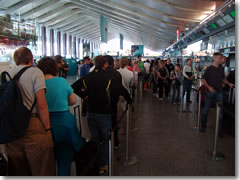- Places
- Plans
- Itineraries
- Experiences

Trains are the easiest and most popular way to travel in Italy, and chances are the first place you'll see in Rome is Termini train station.
First, though you have to get to Rome.
Rome's main train station is Stazione Termini on the expansive, bus-filled Piazza dei Cinquecento. (That means "Square of the Five Hundred," so you will sometimes see it abbreviated "P.za dei 500.")
Termini train station lies on the northeastern edge of the city center, at the north end of Via Cavour. It is the main public city bus terminus in town, and sits at the intersection of Rome's only two Metro (subway) lines.
This squat, 1950s structure ranks as Europe's second busiest train station by volume of passengers. (Since you asked: Paris's Gare du Nord is the busiest.)
The station has become a bustling marketplace, with plenty of eateries and shops, most of them in an underground mall.
At the end of the tracks is a busy area where people nervously watch the flip boards for track assignments.
Note that some offices and businesses will be shuffled around for the next few years as construction work proceeds on a new elevated retail and apssenger space toward the right end of the tracks (19–24).
The train information and assistance office is located in the by track 1 (to the right as you get to the end of the tracks when arriving).
In their infinite idiocy, the powers of the train station have moved the Rome tourist information office (several times, actually) from former, more prominent locations in the main hall area to a hidden little wing called Ala Termini, located 1/3 of the way down the side of track 24 (arriving at the end of any other track, immediately turn left, then left again at the wall).
This is only convenient to people arriving by plane, since it it partway down the ludicrously long walk they have to take to and from the airport train:
Note that, if you are headed to Rome's Fiumicino airport from the Rome train station, the track for the airport express train—Track 25—is kind of hard to find.
Basically: Coming from the ticketing hall and facing the tracks, turn right and go all the way to down to Track 24 , which looks for all the world like it is the last track in the station. it it not. Turn left to walk up the long paltform along the far side of Track 24, and eventually—after about a quarter mile—you will find Track 25. Details and a map are here. » more
The deposito bagagli (left luggage) office (tel. +39-06-474-4777) is near the tourist information office alongside track 24.
It's open daily 6am–midnight and charges €4 for the first 5 hours, €0.60 for each hour from 6 to 12 hours, then €0.20 for each hour after 12.
Beyond the tracks, slip through a wide gap between the phalanx of newsstands and little bars to enter the Galleria Centrale, the main hall with some train information offices and exits at either end leading onto the station's side streets (an area packed with cheap hotels).
Watch out for the hotel touts who will swarm you here (in my experience, any hotel that needs to field these slick salesmen isn't really good enough to get business on a more legitimate and old-fashioned way: being worthy of being passed along by word of mouth or recommended by sites like this or in guidebooks).
Keep walking straight and you'll enter the atrio, or ticketing hall, pictured above with its swooping roof and interminably long ticket lines. (Tip: Unless you need some specific service like getting a Railpass vouched, avoid the lines by using one of the banks of automated ticketing machines.)
Unless you happen to be heading to the area immediately around the Spanish Steps, the bus is a far better bet than the Metro, as Rome's subway system doesn't really serve the core of the historic center but rather skirts its edges.
Nearly every train to Rome goes to or passes through Termini, but a few long-haul trains stop only at the Roma Tiburtina train station in the eastern part of the city.
There are other secondary stations ranged about town—lined up in a gentle arc that pretty much defines the southern edge of the greater historic center—that most tourists never even see.
However, they can be convenient if your hotel happens to be in the neighborhood (perhaps the Roma-Trastevere train station, or Roma-Ostienese train station for the Aventine/Testaccio area), as well as sometimes for hopping regional rail lines for day trips out of town.
Planning your day: Rome wasn't built in a day, and you'd be hard-pressed to see it in that brief a time as well. Still, you can cram a lot into just a day or three.
To help you get the most out of your limited time in the Eternal City, here are some perfect itineraries, whether you have one, two, three, or four days to spend in Rome. » Rome itineraries
Share this page
Search ReidsItaly.com